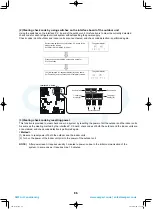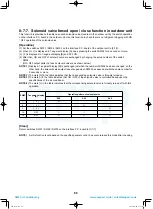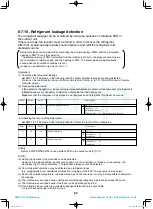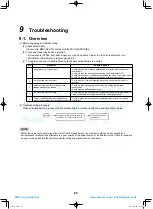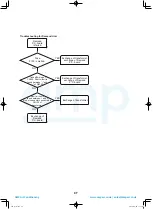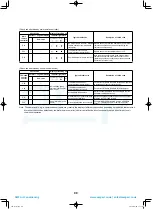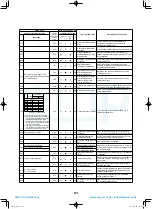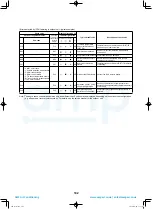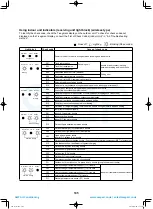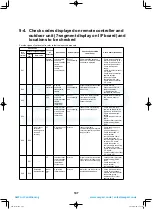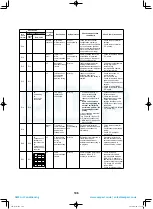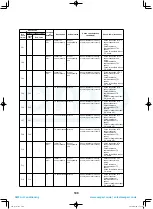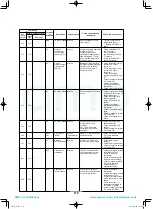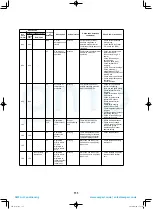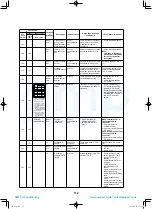
109
9-2. Troubleshooting method
The remote controllers (main remote controller and central controller) and the interface P.C. board
of an outdoor unit are provided with an LCD display (remote controller) or a 7-segment display (outdoor interface
P.C. board) to display operational status. Using this self-diagnosis feature, the trouble site / trouble part may be
identified in the event of a trouble by following the method described below.
The list below summarizes check codes detected by various devices. Analyze the check code according to where it is displayed and work out
the nature of the trouble in consultation with the list.
When investigating a trouble on the basis of a display provided on the indoor remote controller or TCC-LINK central controller - See the
“TCC-LINK remote controller or main remote controller display” section of the list.
When investigating a trouble on the basis of a display provided on an outdoor unit - See the “Outdoor 7-segment display” section of the list.
When investigating a trouble on the basis of a wireless remote controller-controlled indoor unit - See the “Light sensor indicator light block”
section of the list.
List of Check Codes (Indoor Unit)
(Check code detected by indoor unit)
Check code
Display of receiving unit
check code
f
o
n
o
i
t
p
i
r
c
s
e
D
trouble site
Typical
TCC-LINK
central control
or main remote
controller
display
Outdoor 7-segment display
Indicator light block
Sub-code
Flash
E03
–
–
Indoor-remote controller periodic
communication trouble
Communication from remote controller or network adaptor
has been lost (so has central control communication).
E04
–
–
Indoor-outdoor periodic communication
trouble
Signals are not being received from outdoor unit.
E08
E08
.
n
w
o
s
ti
o
t
l
a
c
it
n
e
d
i
s
s
e
r
d
d
a
s
t
c
e
t
e
d
ti
n
u
r
o
o
d
n
I
s
s
e
r
d
d
a
r
o
o
d
n
i
d
e
t
a
c
il
p
u
D
s
s
e
r
d
d
a
r
o
o
d
n
i
d
e
t
a
c
il
p
u
D
E10
–
–
Indoor inter-MCU communication trouble
MCU communication between main controller and motor
microcontroller is troubled
.
E18
–
–
Trouble in periodic communication
between indoor header and follower
unit
Periodic communication between indoor header and follower
units cannot be maintained.
T
L
A
–
–
1
0
F
Indoor heat exchanger temperature
sensor (TCJ) trouble
Heat exchanger temperature sensor (TCJ) has been open /
short-circuited.
T
L
A
–
–
2
0
F
Indoor heat exchanger temperature
sensor (TC2) trouble
Heat exchanger temperature sensor (TC2) has been open /
short-circuited.
T
L
A
–
–
3
0
F
Indoor heat exchanger temperature
sensor (TC1) trouble
Heat exchanger temperature sensor (TC1) has been open /
short-circuited.
T
L
A
–
–
0
1
F
Ambient temperature sensor (TA) Trouble
Ambient temperature sensor (TA) has been open / short-
circuited.
T
L
A
–
–
1
1
F
Discharge temperature sensor (TF)
trouble
Discharge temperature sensor (TF) has been open / short-
circuited.
M
I
S
–
–
9
2
F
P.C. board or other indoor trouble
Indoor EEPROM is abnormal (some other trouble may be
detected).
M
I
S
–
–
3
0
L
Duplicated indoor group outdoor unit
There is more than one outdoor unit in group.
M
I
S
–
–
7
0
L
Connection of group control cable to
stand-alone indoor unit
There is at least one stand-alone indoor unit to which group
control cable is connected.
M
I
S
–
8
0
L
8
0
L
Indoor group address not set
Address setting has not been performed for one or more
indoor units (also detected at outdoor unit end).
M
I
S
–
–
9
0
L
Indoor capacity not set
Capacity setting has not been performed for indoor unit.
M
I
S
–
–
0
2
L
Duplicated central control address
There is duplication in central control address setting.
L30
L30 Detected indoor unit No.
SIM Indoor external trouble input (interlock)
Unit shutdown has been caused by external trouble input
(CN80).
T
L
A
–
–
1
0
P
Indoor AC fan trouble
Indoor AC fan trouble is detected (activation of fan motor
thermal relay).
P10
P10 Detected indoor unit No.
ALT Indoor overflow trouble
T
L
A
–
–
2
1
P
Indoor DC fan trouble
T
L
A
–
–
1
3
P
Other indoor unit trouble
Follower unit cannot be operated due to outdoor unit alarm
(E03 / L03 / L07 / L08).
IPDU: Intelligent Power Drive Unit (Inverter P.C. board)
:
Lighting, :
Flashing, :
Goes
off
ALT: Flashing is alternately when there are two flashing LED
SIM: Simultaneous flashing when there are two flashing LED
Operation Timer
Ready
Float switch has been activated.
Indoor DC fan trouble (e.g. overcurrent or lock-up) is detected.
98
A10-1510.indb 98
A10-1510.indb 98
2016/04/08 17:21:04
2016/04/08 17:21:04
AMP Air Conditioning
www.ampair.co.uk | sales@ampair.co.uk



